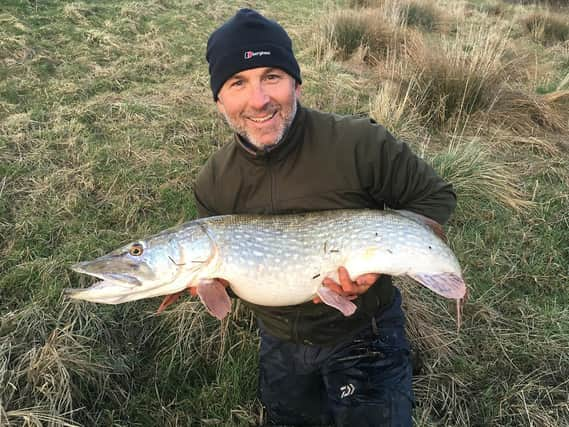How The Domesday Book of Mammoth Pike started a fishy fascination


Yes, I’ve caught them, but everyone has by accident, normally while enjoying a session trotting for dace and roach on the Rother.
Just as these lovely fish are coming to my net a dark green, torpedo-shaped terror has shot out from bankside cover and grabbed my fish.
Advertisement
Hide AdAdvertisement
Hide AdNormally it’s over in a flash and I am left with an empty line or sometimes half a fish but occasionally the pike gets itself hooked just enough for me to slip the net under its somewhat surprised body.
These pike are small, normally under 5lb, and most are males known as jacks.
The biggest pike, those over 10lb, are all females and some grow to monstrous proportions. For a small river fish, it is a terrifying nightmare.
The European or northern pike (Esox Lucius) is the biggest out and out predator found in our waters. Not for them the idea of grabbing a worm or bunch of maggots like the perch – they want fish, alive or dead, and the bigger the pike the bigger the fish it wants to eat.
Advertisement
Hide AdAdvertisement
Hide AdMany years ago, I was given a book by a kindly uncle with the enticing title Fred Buller The Domesday Book of Mammoth Pike - absolute catnip to a budding young angler.
Its pages were filled with incredible stories of ferocious giant pike and how they were caught. That book is now more than 40 years old and I’m sure since then even bigger fish may have been caught, but a couple of stories have always stuck with me.
The first was the biggest pike ever caught – a giant of 90lb that fell to an angler using a shoehorn fitted with treble hooks and trolled behind a boat. The fish measured 5ft 8in, bigger at the time than the average height of a man.
The second was 53lb, made more amazing by the fact the angler had used a live 5lb pike as bait.
Advertisement
Hide AdAdvertisement
Hide AdBoth these pike came from Ireland, for many years the mecca for big pike and for pike anglers.
Almost certainly this size of fish won’t be caught again as they gained weight by eating large amounts of Atlantic salmon that entered the lochs and rivers to spawn.
Since the Atlantic salmon have declined dramatically in the intervening years, big pike have been removed from these waters under the guise of salmon preservation but more likely to support the more lucrative salmon and trout fisheries.
The strange thing is that despite its size, the pike is surprisingly delicate and easily damaged. Careful handling and hook removal is paramount to preserve the fish to fight another day.
Advertisement
Hide AdAdvertisement
Hide AdIn our club waters the pike will grow to impressive sizes. The River Arun has some very big specimens, many topping 30lb, and even a little river like the Rother will hold specimens in excess of 20lb – and catching one can provide some of the most exciting fishing you will find anywhere.
The pike is an out and out ambush predator. Its whole physical make-up screams speed and power.
Lazily holding station in nearby weed cover or within the safety of tree roots, it can with a flick of its huge tail accelerate in seconds to grab its prey.
Nothing is safe. If it fits into that huge maul it will attack. And what a mouth, a long jawline absolutely filled with razor-sharp teeth that once clamped shut will never let go.
Advertisement
Hide AdAdvertisement
Hide AdNo fish is safe, including as we have seen, other pike. It’s not just fish that are a target; woe betide an errant duckling or water vole that strays too close to a pike’s territory.
Tactics-wise the most common method is spinning, casting a shiny lure around the lake or river and slowly winding in. Many of these lures resemble fish but it is the movement that matters.
Pike, like most predators, will chase a moving target, especially one that flashes in the water or gives the illusion of being sickly or wounded.
The other way is to use a legered dead bait or, less common, a float-fished live fish.
Advertisement
Hide AdAdvertisement
Hide AdStrangely for a freshwater fish, using an oily sea fish like a mackerel or a spratt is highly effective, the leak of fish juices spreading an alluring scent in the water. Pike are just as happy to eat carrion as they are to eat a live fish.
The other essential is to use a wire trace. Remember those razor-sharp teeth? Using nylon or even braid will see the fight last only seconds as you and the pike part company and this is not a good thing. Leaving large hooks in the pike’s mouth is definitely a big no-no.
So, in winter, why not try targeting the local pike. The fight is spectacular, tail walking and leaping out of the water is certainly on the cards and the fight will certainly get the blood pumping. It won’t be a Fred Buller-sized monster but you will never forget that first hit as it powers off downstream at a rate of knots as you cling on to the wolf of the river.
Steve Penticost
Petworth & Bognor AC
sussexangling.co.uk